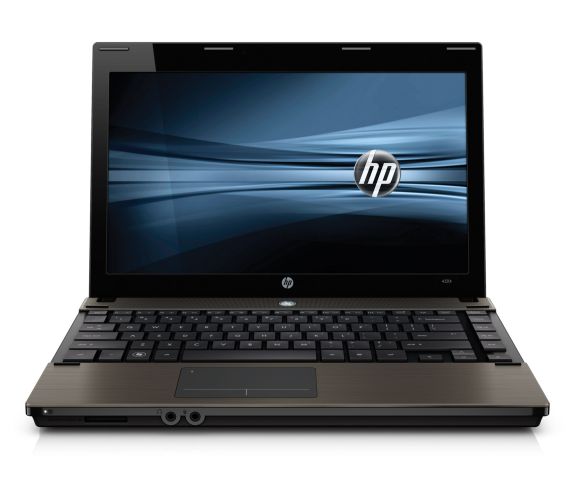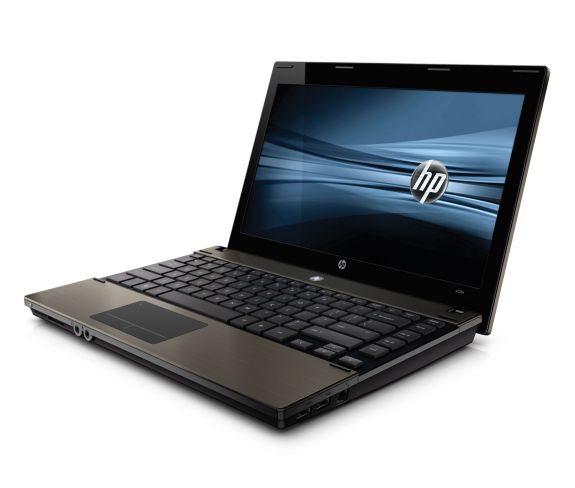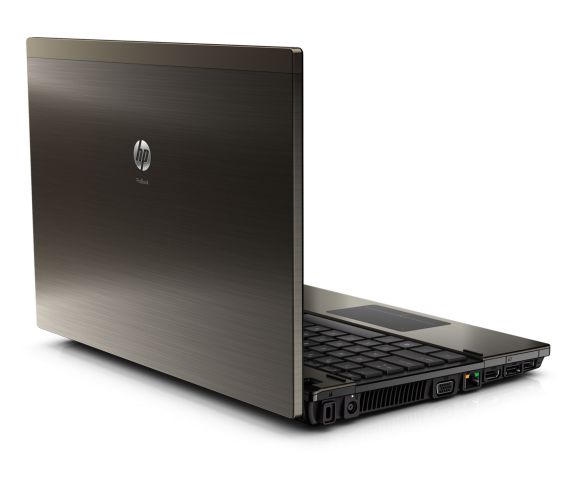Announcing: HP 4320t Mobile Thin Client
by Balraj Sandhu on May 12, 2010 12:01 AM EST- Posted in
- Laptops
- IT Computing
- Intel
- HP
- Announcing
HP 4320t Mobile Thin Client
After launching many consumer and business notebooks last week, HP have announced a further addition to their growing notebook family. The HP 4320t Mobile Thin Client is aimed at the user who regularly accesses servers and other remote storage solutions, and therefore requires a thin, light and reliable notebook where onboard storage is not a concern.
The highlight of this notebook is the brushed aluminum chassis, which HP claim will improve durability. Meanwhile a 13.3” LED-backlit display featuring a relatively lowly resolution of 1366x768 will probably be adequate for the target user.
Performance comes from a 1.8GHz Intel Celeron (presumably P4500) processor on the Intel HM57 Chipset with support for up to 4GB DDR3 RAM. As the primary use of this notebook will be to access remote storage, internal storage is kept to just 2GB or 4GB of solid state memory. An optional DVD drive is available.
Connectivity comes in the form of three USB 2.0 ports, a USB/eSATA combo port, VGA, HDMI, ExpressCard/34, media card reader, microphone and headphone ports. Networking is plentiful with wireless 802.11a/b/g/n and wired gigabit Ethernet with an optional integrated 56K modem. The notebook also incorporates an integrated digital microphone and stereo speakers.
The notebook features a spill-resistant chiclet-style keyboard and touchpad. Long battery life is a must for this type of notebook; for this HP offers 6 cell (47WHr) and 9 cell (93WHr) options for mobility or extra long battery life. They don't specifically state an estimated battery life, but we'd expect the 6-cell battery to last at least five hours for typical business workloads.
The notebook comes with preinstalled software aimed at enhancing the server-client interaction. This includes the Windows Embedded Standard 2009 operating system and software such as File Based Write Filter and Enhanced Write Filter, and HP Virtual Client Essentials.
The HP 4320t Mobile Thin Client will be available in late May from $599. As a notebook entirely orientated around network storage, it seems to fit the bill. However, should that same notebook find itself stranded from its server, that price tag would buy you a much faster notebook with plenty of onboard storage and Windows 7 in the consumer market which would provide a much richer multimedia experience. So the question the target audience will need to ask is whether that slim aluminum chassis and preinstalled software make it worth the same price as a higher spec, more versatile, mainstream notebook?
In my opinion, probably not. Perhaps even more shocking is that despite the "Thin Client" name, the 4320t is actually thicker and heavier than the ProBook 5310m we looked at last month. For those interested, the full specifications are listed below.
| HP 4320t Mobile Thin Client Specifications | |
| Operating System | Windows Embedded Standard 2009 |
| Processor | Intel Celeron ( 1.8GHz, 2MB L2 cache) |
| Chipset | Mobile Intel HM57 Chipset |
| Memory |
Up to DDR3-1333 (depending on CPU) dual-channel memory Supports 1024/2048/4096MB SO-DIMMs, up to 4096MB standard |
| Internal Storage | Solid State Flash Module: 2GB, 4GB |
| Removable Storage | Fixed 12.7mm SATA DVD-ROM optical drive (optional) |
| Display | 13.3" diagonal LED-backlit 16:9 HD (1366 x 768) |
| Graphics | Intel HD Graphics |
| Battery/Power |
6-cell (47WHr) Lithium-Ion battery 9-cell (93WHr) Lithium-Ion battery 65W HP Smart AC, HP Fast Charge |
| Audio/Visual |
HD Audio Stereo speakers Integrated digital microphone |
| Wireless Support |
Broadcom 802.11 a/b/g/n Broadcom 802.11 b/g |
| Communications |
Realtek Ethernet (10/100/1000 NIC) optional 56K v.92 modem |
| Expansion Slots |
ExpressCard/34 slot Media Card Reader |
| Ports and Connectors |
3 x USB 2.0 ports 1 x eSATA/USB 2.0 combo port VGA HDMI Stereo headphone/microphone Power connector RJ-11/modem RJ-45/Ethernet |
| Input Device | Full-sized keyboard, ClickPad |
| Software |
Standard: Internet Explorer 7, Windows Media Player 11, File Based Write Filter, Enhanced Write Filter, WinDVD, Microsoft Remote Desktop Protocol, Citrix XenApp, VMWare View, Terminal Emulation Software, Symantec Endpoint Security Manageability Solutions: HP ThinState Tools, HP Device Manager, HP Client Automation – Starter Edition, Altiris Deployment Client6 HP Virtual Client Essentials: HP Remote Desktop Protocol Enhancements, HP Remote Graphics Software |
| Security | Kensington Lock slot2, HP Privacy Filter Support |
| Dimensions | 1.08" (at front) x 12.74" x 8.98" / 27.49mm (at front) x 323.50mm x 228.08mm |
| Weight | Starting at 4.27 lb/ 1.93 kg (with weight saver; weight will vary by configuration) |













29 Comments
View All Comments
eBob - Wednesday, May 12, 2010 - link
I understand the purpose for this product, but I don't think that the laptop form factor makes much sense. It is practically useless for a mobile professional. Once it is out of range of a network it won't be able to do anything. Even adding 3G won't make much difference because 3G is not as ubiquitous as some people imagine. Once the connection drops to EDGE or something similar the performance will degrade significantly. Also, it will be useless for people trying to get work done on a cross-country flight. I think this would be fine as a small desktop form factor machine and it would likely be even less expensive as such. The laptop does look good though and is probably fairly rugged. I would love to have one with a real processor (Core i5 or i7) and hard drive.nao1120 - Wednesday, May 12, 2010 - link
RE: RE: RE: "Thin" Client? by Justin Time on Wednesday, May 12, 2010
I think you are missing the point.
The 't' models are intended as mobile terminals, not as functional stand-alone notebooks.
Very specific niche market in the business sector.
I agree - 2 to 4 gb of flash storage memory on the unit is designed to hold the OS, and apps needed to connect to servers and nothing else....The entire point of thin clients, is to offer a device to connect to remote servers....
And to comment on where you could store you OWA, and email and exchange issues. That is solved by other solutions, such as file servers, and citrix ....
It does work well, and its currently used on our environments.
It is like its designed for, a dummy terminal, with a sceren/ and keyboard, but in this case, mobile....which is lets face it....Nice.
T2k - Wednesday, May 12, 2010 - link
Seriously, this is such a typical HP case: an very good idea - and a HORRIBLE execution so the end product is a lame duck.Johnmcl7 - Wednesday, May 12, 2010 - link
"Meanwhile a 13.3” LED-backlit display featuring a relatively lowly resolution of 1366x768 will probably be adequate for the target user."This comment seems a bit odd given just about every 13.3in laptop has a similar resolution (normally 16:10). Sony's Z series are the only machines I'm aware that actually have a higher resolution at 1600x900 and 1920x1080. Are there any other companies out there with high resolution 13in laptops? Dell used to be good for high res panels but their XPS 13in machines are stuck with the 1280x800 panels.
John
strikeback03 - Thursday, May 13, 2010 - link
Lenovo uses 1440x900 in the X301RadnorHarkonnen - Thursday, May 13, 2010 - link
Lets trim this one. It has too much things for a terminal.- you can take off the ODD. Isnt really necessary.
- On the network side, something for cisco or a intel 5300 for example, fare do much better.
- Media Card reader ? WTF ?
- 1 USB/Sata port should be enough. VGA might be usefull and HDMI could be there too.
- Sound card on a Dumb terminal ? For Citrix or terminal server ? sound card and speakers off.
- 13.3" diagonal LED-backlit 16:9 HD (1366 x 768) ?? First that isnt HD. Second go at least 1440x900 and up it to 14" if necessary. there are a ton of panels LED backlit at 1440x900 at 14".
- Intel Celeron ( 1.8GHz, 2MB L2 cache) ? Please use something leaner. Less cache and lower clock.
- Add 3G please. This is a thin client, should have conectivity on all forms possible.
With all that taken off , the weight should have been really cut down. The battery life should have been improved or even make the 9 cells version standard.
And please make it thinner. Or you put a monster battery, or just make it thinner.
sxr7171 - Saturday, May 15, 2010 - link
I mean 4.39lbs? For what? A thin client should be less than 2lbs period. You can get a Dell E4200 full laptop that weighs 2.2lbs.jabber - Tuesday, May 18, 2010 - link
I tried to push these whan another firm released thin client laptops.We were a large firm that liked to employ lots of external contractors. The contractors would come in, get given a company laptop due to the 'company IT on the network only rule', do the six months, publish the report then often clear off with the laptop and the company data!
Due to an apathetic IT dept they never got chased after for either.
So I reckoned these would have been handy to stop contractors walking off with all the data plus the laptops would have been pretty useless to take anywhere else.
However, we still had an apathetic IT dept...........you can guess the rest.
Yep we just kept heamorraging Dell lattitude Laptops for years. No wonder so many contractors liked working for us.
Inteli - Saturday, October 20, 2012 - link
Ok. Basically, This laptop is a Thin Client version of the ProBook 4320s. They look Identical (I'm typing on a 4320s right now, and I can't see a difference).I think some people just don't get it, while others do get it. A thin client is just a terminal to connect to a bigger server. Anyone who actually read the article would realize this. I think most people just looked at the product specs, then thought it was a overpriced underpowered laptop. It's not. It's meant to deploy quickly to a server back at HQ or wherever and do all your computing THERE. The reason it has all the extra stuff (Card reader, 4 USB ports, eSATA, etc. etc.) is because they basically took the HP 4320s and swapped out everything except the RAM. Honestly, I don't see why people want higher resolution screens on laptops, at least laptops smaller than 15 inches. My laptop has a 1366x768 res. screen, and it looks fine, and i think it is the right size. It matches the screen size great (with just a 117ppi density) and it also suits the power of the GPU well. Remember. This is only running OG Intel HD graphics. You CAN NOT play games decently on it, even at this "horrible" screen resolution. Honestly, I find more fault in 22" monitors having a 1680x1050 resolution than 13 inchers having a just-above-HD resolution (Yes...This IS HD. anything above 1280x720 is considered HD. it's not FHD, but it's HD.)
/rant
tl;dr The only real fault I can find in this laptop is that it's probably just a bit thick. However, this was Pre-Ultrabook. If HP were to remake this, it would probably match Ultrabook dimensions.